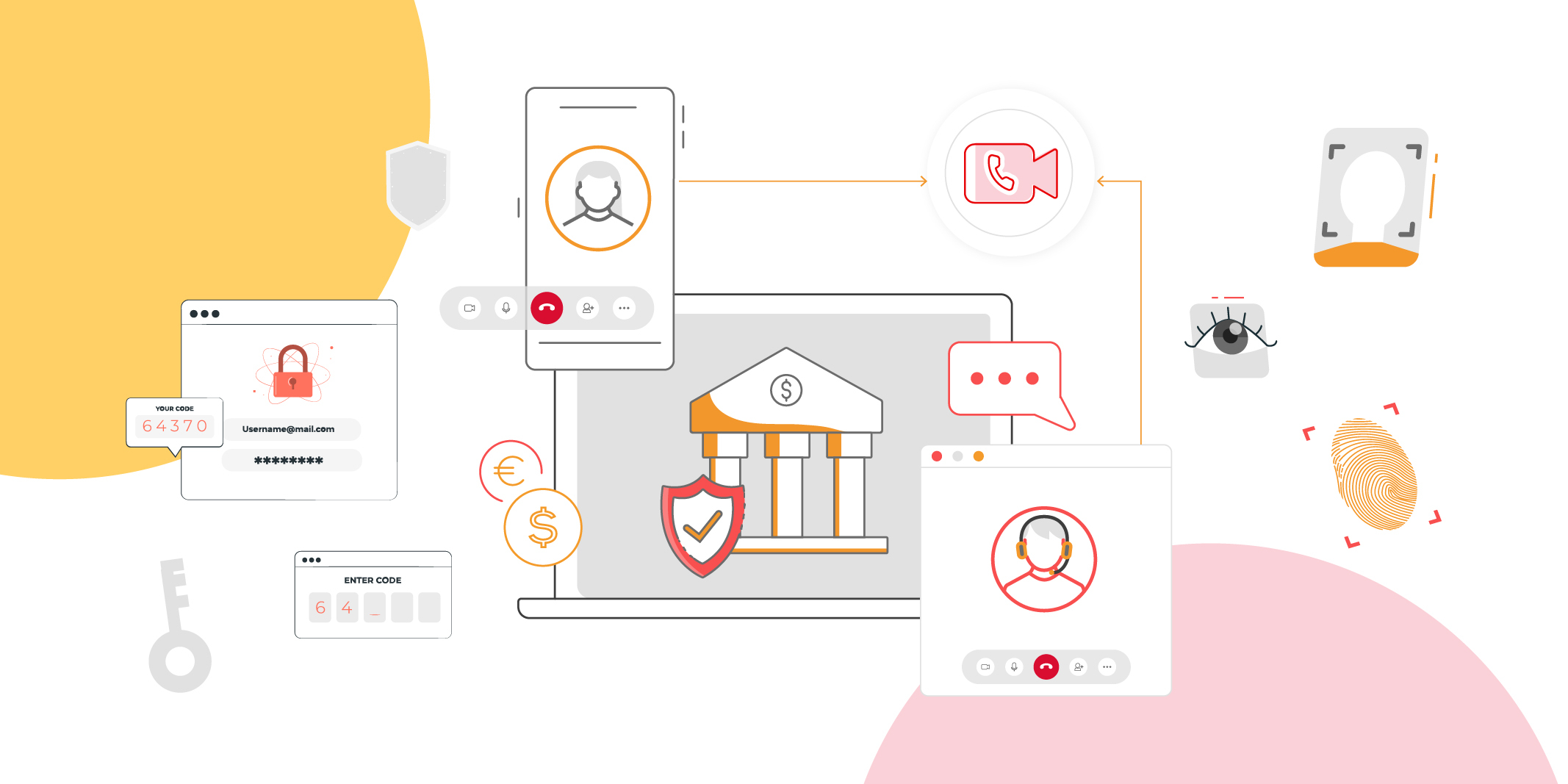With the rising prevalence of online financial transactions, fraudulent activities targeting individuals and institutions have also surged. With numerous accounts and data available at our fingertips, cybercriminals seek to take advantage through deception and theft.
Yet technology also provides solutions to help guard against such threats. One such innovative tool that has risen to meet this need is WebRTC video calling, enabling real-time “face-to-face” identification and monitoring of exchanges in the digital world.
This blog explores the rise of video calling in business and sheds light on how it has become an instrumental tool in preventing fraud.
The Rise of Video Calling in the Financial Sector
The use of video calling in highly regulated industries such as banking and finance has grown tremendously in recent years. With more transactions and customer service occurring remotely, having a visual communication channel has become paramount.
Financial institutions have rapidly adopted real-time audio and video platforms to allow meetings, consultations, and account services to continue seamlessly. Customers have embraced these virtual options as well, driving further adoption of video by banks, investment advisors, loan officers, and other financial professionals.
The use of live video chat for banking jumped from 17% to 27% from 2019 to 2021, and 64% of these users were “very satisfied” with their most recent experience. – (The Financial Brand)
What was once seen primarily as an occasional convenience transformed into an essential tool supporting the remote operations of organizations.
The shift towards digital has been accelerated by the pandemic but was already underway as customers expected more flexible options. Younger generations are especially comfortable conducting life’s business virtually.
Financial institutions are meeting these rising demands through extensive investments in high-quality video technologies integrated into their websites and apps. Employees also rely heavily on video conferencing for tasks like remote collaborations, internal training, and more.
Its easy-to-use, face-to-face nature has made video calling the preferred interface for many virtual financial interactions on both the consumer and enterprise side.
Common Methods of Financial Fraud
As the world shifts to digital, fraudsters are exploiting new opportunities to commit financial crimes. In order to protect our finances, it is important to be aware of the various methods used by fraudsters.
Here are four common techniques employed by scammers to deceive and manipulate unsuspecting victims.
Identity Theft
Identity theft remains one of the most prevalent types of financial fraud. Criminals are able to steal people’s personal identifying information like Social Security numbers, dates of birth, driver’s license numbers, and even full addresses through a variety of means.
Data breaches of large companies are a primary source of compromised credentials. However, fraudsters also look through trash bins for discarded bank statements, tax documents, or pre-approved credit offers.
Once they have the details, identity thieves can open new lines of credit, file fraudulent tax returns, obtain government benefits, or initiate wire transfers in the victim’s name without their knowledge. This can wreak long-lasting damage, such as bankruptcy and black marks on credit reports.
Phishing Scams
Phishing scams continue to plague consumers through plausibly deceptive online messages. Fraudsters craft emails, texts, or pop-up windows appearing to come from trusted sources like banks, PayPal accounts, or shipping companies in order to coax individuals into entering login credentials or updating personal information.
These attacks emulate the official branding of legitimate organizations to avoid suspicion. Sometimes hyperlinks in these phishing lures install malware that tracks keystrokes to harvest even more data over time. Social media networks are increasingly exploited as well to target contacts with tailored phishing content.
Synthetic Identity Fraud
The crime of synthetic identity fraud is growing at an alarming rate. Criminals generate fictional identities by coupling invented Social Security numbers with real people’s stolen details like names, dates of birth, and addresses.
Since there is no pre-existing credit history tied to these fabricated identities, fraudsters can more easily qualify for new lines of credit and avoid triggering identity theft alerts. Often, they take out numerous high-limit cards and loans before failing to make payments and disappearing. Synthetic identities are harder for victims and companies to detect and resolve.
Account Takeovers
Account takeovers involve the unauthorized accessing of existing financial and payment accounts. Thieves leverage credentials obtained through phishing efforts, data leaks tied to previous security breaches, or malware deployed on victims’ devices.
They then transfer balances, withdraw funds, or make fraudulent payments before the legitimate accountholders notice any irregular activity. Two-factor authentication bypassing has advanced this type of fraud substantially in recent years.
The Role of Video Calling in Fraud Prevention
Video calling has emerged as a robust tool in the financial sector for combating fraud and strengthening security protections. It offers several critical characteristics that contribute to an effective fraud prevention framework.
Verification of Identities in Real-time
Real-time visual identification allows financial institutions to verify customer identities during calls. By visually confirming a person’s appearance in real-time, banks can minimize risks like identity theft or impersonation. This real-time visual ID checking introduces an extra layer of security to help prevent fraudulent acts.
KYC
The significance of video-based KYC (Know Your Customer) in the financial sector cannot be overstated, especially in terms of fraud prevention. By incorporating video calls for customer verification and onboarding, financial institutions can ensure a secure authentication of new customers. The seamless integration of video communication channels guarantees compliance with existing security protocols, including secure file-sharing.
Moreover, video-based KYC offers an additional layer of protection against identity fraud and elevates the efficiency and accuracy of the onboarding process. It facilitates real-time interaction and verification, mitigating the risk of fraudulent activities and establishing a more robust financial environment.
Recording Interactions for Later Review
Recorded video-calling sessions can later be analyzed to detect suspicious patterns or behaviors. Advanced technologies have the ability to examine recorded sessions to find any red flags, such as unusual user interactions or suspicious activities. This behavioral analysis provides important insights for fraud detection and prevention, enabling financial institutions to proactively address risks.
Direct and Personal Interaction
Video calling helps create a personal connection between customers and bank representatives, fostering trust and transparency. This personal interaction permits bank staff to observe customers’ facial expressions, body language, and overall demeanor, aiding the detection of possible fraud or deception signs. Suspicious behaviors or inconsistencies in customer engagements can be more easily identified through video calls, allowing timely intervention and prevention of fraudulent acts.
By incorporating video calling into their fraud prevention strategies, financial institutions can leverage the power of real-time identity verification, behavioral analysis, and personal connections to safeguard against fraudulent activities. This technology not only strengthens security measures but also enhances customer trust by providing a safer and more transparent banking experience.
Case Study – Widiba Utilizes Kaleyra’s Video Solution to Combat Fraud and Elevate Customer Experience
Widiba, a digital bank, leveraged Kaleyra’s video solution to not only enhance the customer experience but also combat bank-related fraudulent activities. With an increasing demand for flexibility and efficiency in virtual services, Widiba aimed to meet customer expectations by offering video calling capabilities.
By implementing Kaleyra’s video banking services, Widiba achieved the following:
Strengthening security measures: Widiba recognized the importance of secure communication channels to prevent bank-related fraudulent activities. Kaleyra’s video solution provided a native and secure channel based on the WebRTC protocol, ensuring encrypted audio and video interactions between the bank and its customers. This enhanced security measures and protected sensitive customer information during video calls.
Personalized remote interactions: The integration of Kaleyra’s video solution, termed “Dialogue,” allowed Widiba’s customers to engage in face-to-face video calls with their financial advisors. This personalized approach not only fostered trust and strengthened customer relationships but also provided an additional layer of security by enabling visual identification of both parties involved in the communication.
Efficient query resolution: Customers could initiate video calls instantly from Widiba’s digital touchpoints, eliminating long waiting times. This immediate response reduced the likelihood of customers seeking information from potentially fraudulent sources. Kaleyra’s video API seamlessly connected customers with the assigned bank agent, enhancing query resolution efficiency and minimizing the risk of unauthorized access to customer accounts.
The collaboration between Kaleyra and Widiba yielded significant benefits in preventing bank-related fraudulent activities and enhancing the customer experience:
Fraud prevention: By ensuring secure, encrypted video communication channels, Widiba successfully mitigated the risk of fraudulent activities such as phishing attacks and identity theft. The visual verification process during video calls added an extra layer of security, protecting customers from potential scams.
Enhanced customer trust: Widiba’s proactive adoption of video banking showcased its commitment to customer security. This approach built trust and confidence among customers, knowing that the bank prioritized their safety and took proactive measures to prevent fraud.
Improved customer experience: The seamless integration of Kaleyra’s video solution empowered Widiba’s customers to conveniently engage with their financial advisors from anywhere. This personalized and secure interaction not only enhanced the overall customer experience but also reduced the chances of customers falling victim to fraudulent schemes.
Final Thoughts
As we continue to move towards a more digital world, the importance of keeping our information safe cannot be overstated. This is especially true for businesses in the financial sector, where customers entrust their sensitive financial information. Fortunately, there is technology available to help protect against potential threats. It’s time for you to take advantage of this technology not only to protect yourself but also your customers.
By doing so, you can provide the necessary assurance to your customers that their information is safe and secure. Let’s work together to stay ahead of potential risks and ensure a secure future for everyone.

Harish Thyagarajan
Content Marketer
Supercharge Your Communication!
Get in touch with our experts who strive hard to bring the very best in cloud communications technology to you.


